You will find articles organized by categories, along with recent comments, along the right hand column of the website. If you are just getting started with the idea of converting a gas car to electric be sure to check out Your First Electric Car
Welcome and enjoy!
-Jerry
A Brake in the Weather · 19 April 06
Good news! I’ve pretty much wrapped up the brake work on Eve. Yes, that means no more bad puns…at least about brakes.
This photo isn’t actually of Eve’s front disc brakes, but of our old VW Golf. The Golf is due for inspection but the front brakes have been pretty noisy so I figured I’d work on them while working on Eve’s brakes. Good thing I checked, the front rotors and pads were in pretty bad shape.
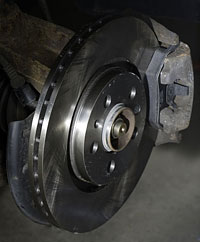
New England really needs to come up with a road de-icer that doesn’t eat cars…
That looks much better!
I’ve never worked on this car’s brakes before and was surprised at how easy it was. Once you get the wheel off the rotor is only only held on by a single screw (and the brake assembly).
The brakes are held on by two allen-headed bolts, nicely enclosed in rubber boots. Anyone who’s whacked the crap out of their knuckles and tools trying to free rusted bolts would certainly appreciate how nice these were to take off.
Bonus points for not having to mess with the bearings. Wish I could say the same for Eve.
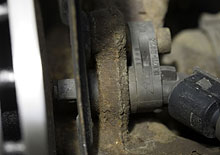
While I was poking around I took this picture of the ABS sensor. The sensor is a little magnetic pick-up assembly positioned right next to a slotted steel plate mounted behind the rotor. The plate spins with the wheel, while the sensor sits in one place “watching” the world go by…
The ABS computer most likely gets regular pulses as the wheel spins which it turns into an RPM for each wheel. Should one of the wheels start sliding on ice, essentially zero RPM or much smaller RPM than the other wheels, the ABS computer can shut off the hydraulic pressure for that wheel until it starts spinning again.
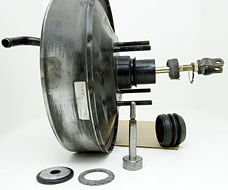
Anyway, enough of that ol’ car, let’s get back to Eve.
Since I have an electric vacuum pump and plan to keep the vacuum assist braking I decided to examine and clean the vacuum booster.
First off it was obvious that the old master cylinder was leaking and for some reason the booster was rusting (you can see a pre-cleaning photo here). This is what they call foreshadowing.
As you can see I took it apart. Click the images for larger views. The right side shows the rod that the brake pedal pushes against. I’ve pulled off the rubber seal and the “filter” material. When you push the brakes the vacuum inside the booster sucks in air from this side. It’s essentially helping pull the brake pedal and making it easier on your foot.
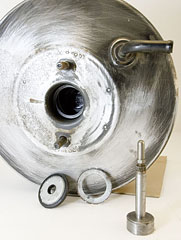
On the other side of the booster, between it and the master cylinder, is a pusher rod. It goes through a flat rubber washer (shown in the front) and pushes/compresses the hydraulic fluid in the master cylinder.
The flat, thick disk area goes into a notch that is on the working end of the other rod. This way it can push without going too far off center or slipping.
I’m not quite done with the booster though. It has been painted, everything put back into place, but there’s a small vacuum leak around the seal. Maybe these seals aren’t really meant to be messed with?
Remember what I was saying about foreshadowing? I’m kind of wondering if the last owner didn’t get some water in the brake oil by accident or something.
This is the rear drum brake hydraulic wheel cylinder. When I popped off the rubber boots to inspect them I was surprised to find an oily, rusty mixture oozing out.
This is what a brand new set looks like. Nice. Well, they ought to be, probably the costliest part of the bunch.
I had been holding off on buying the rear brake parts for a while. After reading an article on replacing the entire rear drum brake assembly with disc brakes (from another Probe model) and seeing the shape of these I thought maybe I might just go the rear disc route. Calls to local junkyards came up empty, one old fella saaying, “Sure, had about 20 of them…last year. I crushed ‘em all!”
Rear drums it is…
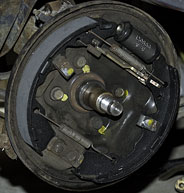
Here’s the whole assembly put back together. Before I finish off the back-end completely I need to pick up new bearings and find someone to press them.
An EV is all about optimization and low rolling resistance is one of the big ones. One of the guys mentioned in the comments a while back that his EV was using more current on flat stretches than he thought it should. Turned out to be his brakes being stiff and not fully releasing when he let off on the pedal. While I’ve got Eve up on stands and all taken apart I figure I fix up whatever I can.
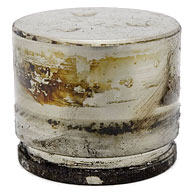
The front brake calipers weren’t as rusty as the rear, but they were pretty worn so I decided to replace them as well.
This photo, in case you are curious, is the little piston inside of the front caliper. Hydraulic oil pushes against the flat surface which in turn pushes and therefore squeezes the brake pads together. There’s a piston seal gasket inside the caliper and a rubber dust cover boot around the outer edge snapped onto the groove on the piston to keep hydraulics in and dirt and water out.
Unfortunately while putting the new assembly on the left front I noticed that the rotor assembly had play in it. Checked the right side, no play. The manual shows this elaborate measuring setup to precisely measure the amount of play allowed before the bearings need to be replaced. Suffice to say even the most insensitive among us could easily tell the bearings are shot.
Brakes are done, bearings are next. Back to the parts store.





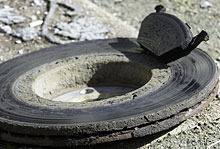
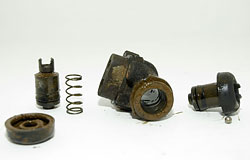
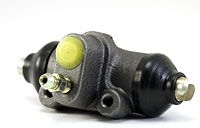
Brake fluid is hygroscopic (readily absorbs water) so the rust in your system is probably (as you surmised) a symptom of very old, soggy brake fluid, though it probably just picked it up through normal use, not as a result of accidental contamination. It’s likely Eve still had her factory-supplied fluid when you took the system apart. All this brake fluid water stuff was news to me until I got my VW a few years back and saw that they specify a 2-year change interval on the fluid. Which reminds me, I’m due!
You’re lucky with the brakes there. I had a Plymouth Laser that was even easier to change the brakes on – after the wheel was off, one bolt removed was all that was required to swing the caliper out of the way. The rotor was held on there by the wheel, it would just pop off if you pulled it with the wheel off. I had the misfortune of working on my sister’s Mazda Protege once… Mazda decided that it’d be better to rivet the caliper onto the mounting bracket, rather than bolt… So to change the brake pads, you had to bring it to Mazda, or invent something to replace the large rivet you’d have to chisel out.
Changed the rotors on my wife’s 94 Buick. Easy and quick. Would have had them turned, but they don’t leave much extra metal to cut away before they are too thin.
Brake fluid absorbs water vapor everytime you check the level by removing the cap (DOT 3).
Silicone fluid doesn’t.
Thanks everyone, didn’t realize brake fluid was such a water magnet!
I’ve worked on my cars forever and can safely say that I’ve never even thought about changing the brake fluid. Since most of us converting EVs are using an old car it only makes sense to go through the system and clean it up. Any other recommended flushing/replacing items?
1. Make sure to replace all the rubber/stock brake lines. These tend to swell with constant exposure to the brake fluid. (If it’ll damage your paint, think of what it’s doing to the rubber)
The lines can swell and act as a one-way valve. My ‘67 LeMans had the original rubber hose line and no matter how I tried, I could not get the rear drums off till I vented the slave cylinders. The fluid came out as if someone was standing on the brake pedal.
It’s been my experience that since the late 70’s, auto manufacturers have produced disc rotors will less metal (and less rotating mass). My policy is that if the rotor is in need of surfacing, I just replace it. I’ve had too many warped rotors due to the mechanic turning the rotors. Within weeks of surfacing, the pedal develops a tell-tale pulse. Next visit to the shop requires rotor replacement. This looks to me like a great scam by less than reputable shops. My old Honda had brake problems every six months till I talked with a mechanic that explained this to me.
Hope this helps!
Additionally…
If you’re going to use DOT 5 brake fluid (Silicone) make sure that all DOT 3 brake fluid is completely cleaned out of the system. DOT 5 & DOT 3 don’t mix too well.
i can vouch for kendall’s comments. my 89 accord had all 3 problems he described: a partially collapsed rubber flex-line acting as a check-valve (dragging one wheel); semi-annual rotor warping (i understand this was a honda weakness for this model); and i also burst an otherwise apparently “good” flex hose during hard braking – and lost brakes as a result. fortunately for me, i had enough room to use the transmission and the hand brake to stop safely.
Brake hoses can fail internally, but it is not very common any more. Having worked as a truck and bus mechanic for over 20 years, I really have not seen more than a few collapsed brake hoses. Definately one of those “if it is not broke, do not fix it” things!
DOT 5 brake fluid is INCOMPATABLE with any other brake fluid, and EVERY old part in a brake system. To change to DOT 5 from DOT 3/4 one MUST replace every hose and seal (master cylinder, ABS, caliper, wheel cylinder) there is in the system. Failure to do so WILL cause excessive swelling of the rubber components (hose/seal) and an inoperative brake system.
Volvo has had brake fluid listed as a maintenance item for over 35 years – it is avery good policy to replace your DOT 3/4 fluid ever 2 or 3 years by completely bleeding the system.
One more thing about DOT 5 (Silicone) brake fluid, while it is not hygroscopic, it is VERY much aeroscopic (likes air). This can make it very difficult to completely bleed all air from the brake system.
As others have suggested, I will NOT turn a rotor. If it looks like it needs to be resurfaced, I replace it with a quality new part (not some imported junk for $10).
Hi Jerry, I just found your site tonite and I had quite a good read and caught up on project Eve. I am starting research for my own EV conversion project and it sounds like you might need some help with some welding? maybe some metal fabrication? I would like to offer my services in exchange for tapping your knowledge on EVs. Send me an email, I’m in Boston.
Thanks for all of the DOTs, dudes! I’ll probably stick to the tried and true old style fluid for now. Good idea on checking hoses.
Nate, thanks for the offer. Tips, advice, and tall stories are free of charge here at EVConvert!
Hey Jerry,
Again I come into your blog late but am glad you didn’t need to pay homage to the knuckle gods this time.
As I mentioned in the other post about the “CARUCK”, I did run a garage and it was in New England, Portland Maine to be precise. Strictly Brakes & Exhaust was the name of the shop and most likely JohnG like myself, has turned wrenches for most of his life.
The majorities’ comments and their experiences are right on however I need to emphasize so further readers don’t get confused; Brake Fluid is not Oil…
They do not mix and the rubber components as well as the actuation systems of automotive brakes are comprised of different materials then say an oil seal. Once a breaking system gets exposed to a petroleum based product the internal rubber components will swell to outlandish size.
If you had ever popped a master cylinder cap on an old Chevy or Dodge and had its cap seal jump out at you like snake that has been coiled up just waiting to strike, then you would understand what I mean.
Also brake hoses are a series of layers with a rope cords to strengthen them. Like a garden hose, if you cut it in two you would see them. The inner lining can collapse acting like the for mentioned valve letting fluid travel one way then closing behind holding calipers engaged after removing your foot from the pedal.
To answer where this mysterious brown ooze came from or how it formed; one only need to understand the great pressure that brake fluid is placed under when asked to rapidly move through out its workings and the climate for which it is doing it.
The rapid movement through the metal lines and the hydrodynamics that occur along with the hydrostatic characteristics of brake fluid create condensation that over a period of time builds up throughout the system lowering the boiling point of the fluid for which as it mingles along inside causes internal corrosion. This corrosion then adds to the fluidic contamination comprising of the cast metal particles, phenolic and or aluminum composites.
Most brake system uses DOT 3 or DOT4 which is a glycol-based hydraulic fluid where as DOT 5 is silicone-based and NOT recommended for any vehicle equipped with antilock brakes of which your Probe does have as you pointed out and described quite well on how it functions I might add.
Here is a link to an old topic of DOT 3-4 vs. DOT 5 in BMW’s; I hope it helps you and others in their future converts.
http://www.xs11.com/tips/maintenance/maint1.shtml
Dan P
hey jerry,
in this article you mentioned something about a de-icer that doesn’t eat up cars. I’ve traveled to many places and I think Montana has the best idea. they use wood chips and sawdust. sure it makes a mess but it doesn’t eat up your car.
I have a ’99 Chrysler 300m, 135,000 miles. Brakes….work great all year round, new front rotors ABS works, check light cycles on & off at startup, completely flushed brake system with Valvoline Syn fluid compatible with Dot 3 & 4, all year round brakes are fine…..UNTIL…..it gets hot and humid here in Ohio. The break pedal free play decreases as heat builds in the engine compartment, the stiff brake pedal still works the brakes well, and then the wheels eventually bind to the point they are stopping the car, not locked up totally, just pressurized. I do not feel that lines or calipers are a problem. When the brake binds, you pull off to the side of the road, turn the engine off. Pump the brake pedal hard a couple times, and VOILA…..the calipers free up and the pedal free play returns. Start up and drive some more using the brakes, and the free play disappears and same thing. I plan to change the power brake booster today. Any thoughts on this from anyone would be appreciated!
Thanks
Coaldigger
Sounds like you have a pressurized ABS braking system.
Pumping the brake pedal a few times with the engine off depressurizes such a system.
The first place I would be looking in this situation would be the Master cylinder.
Thanks DanP, I changed both bake booster AND Master cylinder (while I was getting to the booster) and for $125 for both, seems to be working well now, no decrease in pedal freeplay in hot weather nor the calipers binding the rotors. Thanks again for your opinion.